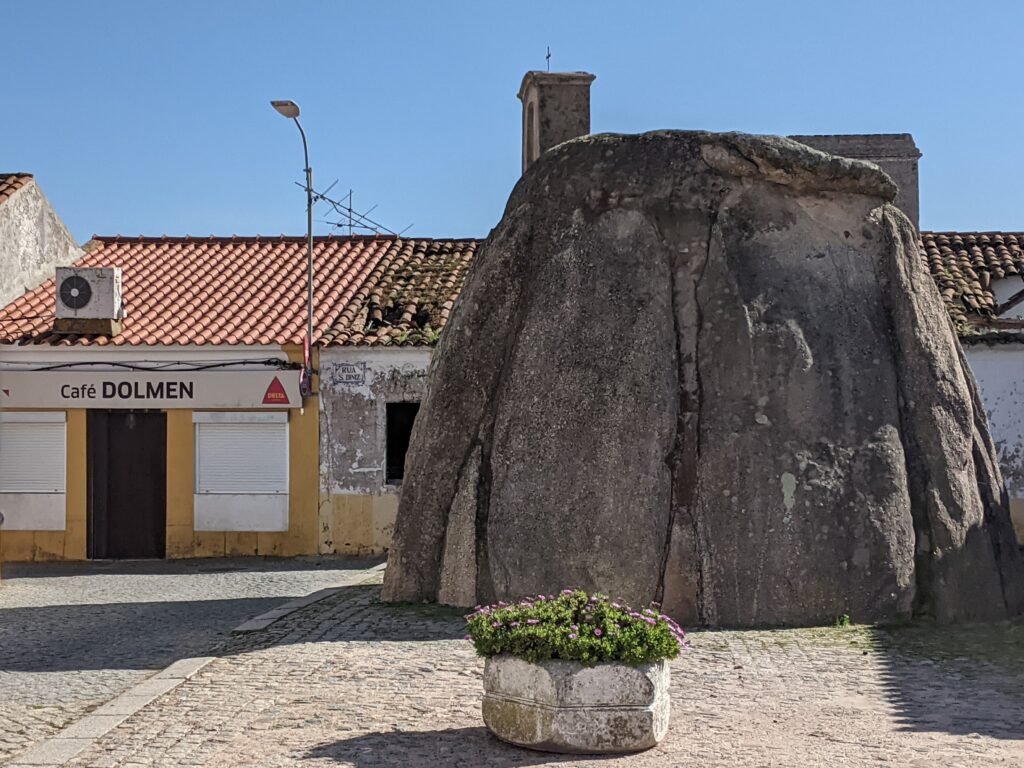Also called: Anta de Pavia
The enormous dolmen stands proudly in the square, grey and hulking beside the traditional yellow and white Alentejana buildings. It presents its original rear towards the square, but as you head around to its entrance its transformation becomes clear. The squared-off stone entranceway replaces the original corridor, and the cross and bell-tower on the top of the dolmen proclaim its rebirth as a Christian chapel. Peer between the bars of the locked entrance, and you can see the azulejo tiles of the altar and a portrait of Saint Dinis. This ancient tomb is now a celebrated modern chapel, giving it a modern life on top of its ancient traditions.








The dolmen is vast, with a chamber that’s more than 3 meters tall and over 4 meters across. It dates back at least 5,000 years, and has been identified as late Neolithic or Chalcolithic. It would have originally had a corridor attached, but only the chamber has survived. The town of Pavia was first given a charter in 1287, and the dolmen was first described in writing in the 16th century. By the 17th century, the dolmen was consecrated as a Christian chapel for Saint Dionisio, or Saint Dinis. (Some signs say “Diniz.”) In 1910, the dolmen-chapel was declared a National Monument. Archaeological investigations throughout the 20th century have produced a variety of artefacts from stone axes to schist plaques (which are now in the National Museum of Archaeology).
There are a number of anta-capelas around Portugal. The most well known are the Anta-Capela de São Brissos (near Escoural, about 60km away) and the Anta-Capela de Alcobertas (about 130km away).
Location
In Alentejo region, district of Évora, municipality of Mora, town of Pavia.
Access
The dolmen-chapel is located in the Square of the Fighters of the Great War, next to the Church of Saint Francisco. There is street parking all around.
Signage



There are signposts on entry to the town of Pavia, directing you to the anta S. Diniz.
Links
- Article (in Portuguese) from Wikipedia
- Description (in English) from the Municipality of Mora’s Travel App
- Description (in Portuguese) from the Interactive Megalithic Museum of Mora
- Entry (in English) of the Megalithic Portal
- A video (captions in English and Portuguese) from Discover Portugal
- Description (in English) from Archaeological Portal of Directorate-General of Cultural Heritage
- Designation (in Portuguese) as National Monument by the Director-General of Cultural Heritage
Nearby
There are many megalithic sites in the area: the closest is the Anta Lapeira along the main road from Pavia towards Vimieiro or Estremoz.

Pingback:Cromeleque das Fontainhas - Prehistoric Portugal
Pingback:Antas da Lapeira - Prehistoric Portugal
Pingback:Anta do Estanque - Prehistoric Portugal
Pingback:Anta-Capela de São Brissos - Prehistoric Portugal
Pingback:Dólmen or Anta-Capela of St. Mary Magdalene - Prehistoric Portugal